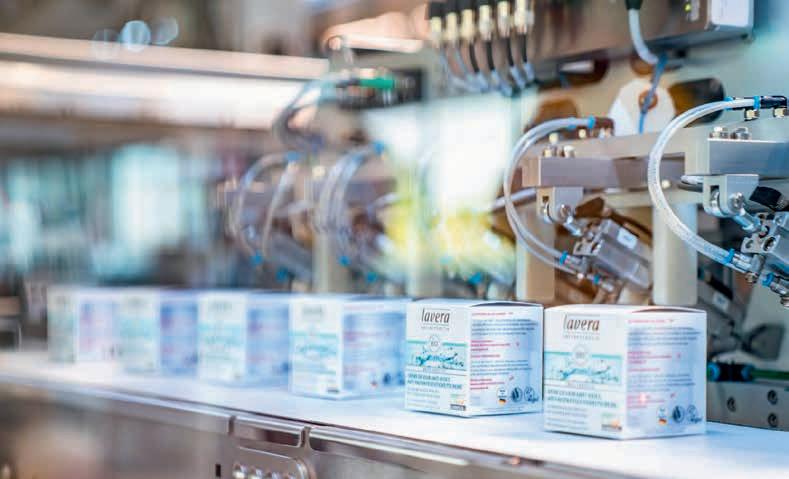
5 minute read
Together for the environment
Since its inception, Laverana GmbH & Co. KG, known as the manufacturer of the natural cosmetics brand Lavera, has placed great importance on the conscious use of precious resources and has been operating on a carbon-neutral basis since 2019. Unsurprisingly, controlled energy consumption remains a key focus at the company, which has a host of ideas, initiatives, and projects in place to support this endeavour, and the new KAESER compressed air station at Bantorf is also playing an integral role.
The demand for natural ingredients in cosmetics is higher today than ever before. However, the natural cosmetics brand lavera has pursued the vision of manufacturing exclusively natural cosmetics and making them accessible to all for over 35 years. With this concept in mind, Thomas Haase, still the managing partner today, founded his company “Laverana” and the “lavera” brand in 1987. From the outset, the company eschewed microplastics, mineral oil-based ingredients, silicone oils and chemical colourings. Therefore, with their high-quality natural cosmetic products, they have been fulfilling the beauty wishes of customers worldwide for over 35 years.
With approximately 450 employees and distributing around 250 products in 40 countries, Laverana has grown to become one of Europe’s leading natural cosmetics manufacturers. The company uses over 300 organic plant-based ingredients, which it largely produces itself in the Hanover region. With the exception of decorative cosmetics, the gel and cream formulations are biodegradable according to the OECD, and both the products and the company have been carbon-neutral since 2019. (CO2 emissions are reduced, whilst unavoidable CO2 emissions are offset by the purchase of emission reduction certificates). Laverana supports various climate protection projects and is committed to reforesting woodland and natural areas in Germany, Austria and France. In 2021, the company was awarded the European GREEN BRAND quality seal for the sixth time in a row for its ecologically sustainable corporate management. Moreover, the natural cosmetics manufacturer won the German Sustainability Award in 2023 for its pioneering work and commitment to sustainability.
Given the immense importance of environmental and resource protection at Laverana, it is no surprise that the focus during planning of the new site in Barsinghausen-Bantorf (from 2019 to 2021) was on sustainable energy management for the new factory. Aiming to cover one hundred percent of its electricity needs in-house and exclusively from renewable energy sources, a large photovoltaic system with a peak output of 750 kWp was installed on the factory roof and integrated into the electricity grid this spring. Moreover, plans are afoot to acquire the Expo wind turbine, located just a few hundred metres away.

Cut from the same cloth
In terms of its unwavering commitment to sustainability, the natural cosmetics manufacturer aligns perfectly with KAESER, the Coburg-based compressed air systems provider. “We have enjoyed a close partnership with KAESER for over 30 years now. Although there are several compressor suppliers out there, the company founder, Thomas Haase, chose KAESER from the very beginning because the mid-sized company shares Laverana’s commitment to sustainability and stands out due to its exceptional technical expertise and dedication to quality,” says Karsten Neupert (TGA and Technical Control Centre). It was therefore clear that KAESER was the only choice as the supplier for the new Bantorf site’s compressed air station. “For the new compressed air station, it was important to us for it to operate with maximum energy efficiency and reliability, and with minimal maintenance requirement,” explains Karsten Neupert. Therefore, everything that cutting-edge compressed air engineering technology has to offer is installed in the new, ultra-modern compressor room.

To achieve the strict purity class of 1-4-1 as per ISO 8573:2010, a sophisticated compressed air treatment system is in use, comprising three SECOTEC TF 280 energy-saving refrigeration dryers, various filters and an activated carbon adsorber. Generously dimensioned flow cross sections ensure uniform flow with an exceptionally low pressure loss of maximum 0.1 bar. In this way, the discharge pressure of upstream compressors and the energy costs for compressed air generation can be kept as low as possible. The total of six rotary screw compressors (three ASD 40 and three BSD 75) are all equipped with IE4 Premium Efficiency motors, which further enhance overall system energy efficiency. Moreover, the screw rotors’ flow-optimised SIGMA PROFILE additionally contributes to improved specific package input power. KAESER’s compressor controllers also score top marks when it comes to energy efficiency: the internal SIGMA CONTROL 2 allows compressor performance to be precisely adjusted according to actual compressed air demand, whilst the SIGMA AIR MANAGER 4.0 master controller monitors and controls the entire compressed air station. It enables efficient interaction between all of the compressors, coordinates compressed air production and demand, and balances compressor load hours to ensure that the entire compressed air station operates at peak efficiency at all times.

The Bantorf site uses compressed air for pneumatic control of the systems and for handling of the products throughout the process across all 45 lines in the four filling halls. The necessary pressure level of 6.5 bar was determined as the result of numerous tests that aimed to identify the lowest pressure sufficient to comfortably meet the demand at the consumers. After all, the ironclad rule here is that every 1 bar drop in pressure results in at least a 6 percent energy saving. Last but not least, all six rotary screw compressors are ready-equipped with two pipes each for future heat recovery. The plan is indeed to utilise the compressors’ exhaust heat, alongside the thermal energy from heat pumps, for building-heating purposes.









